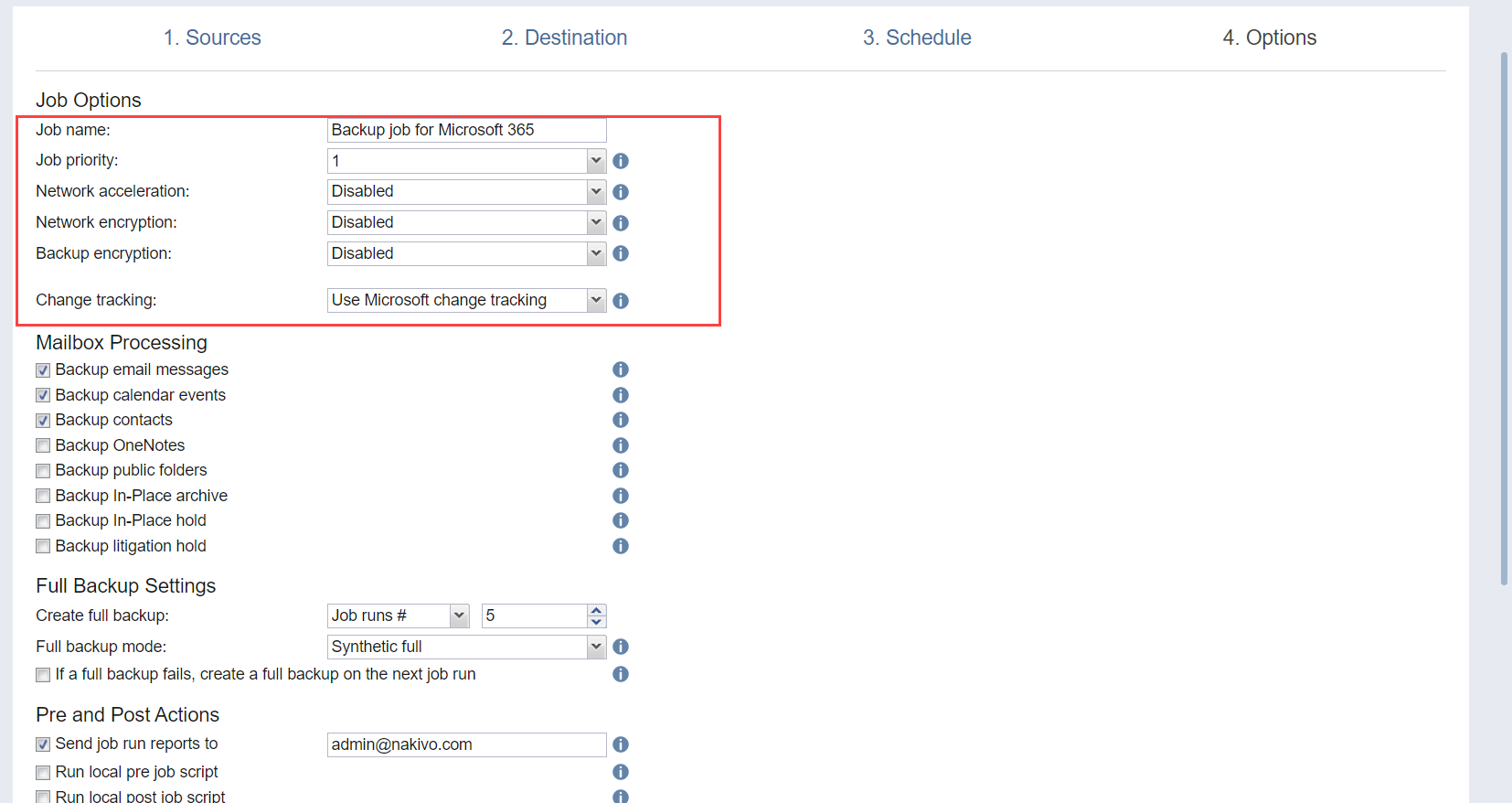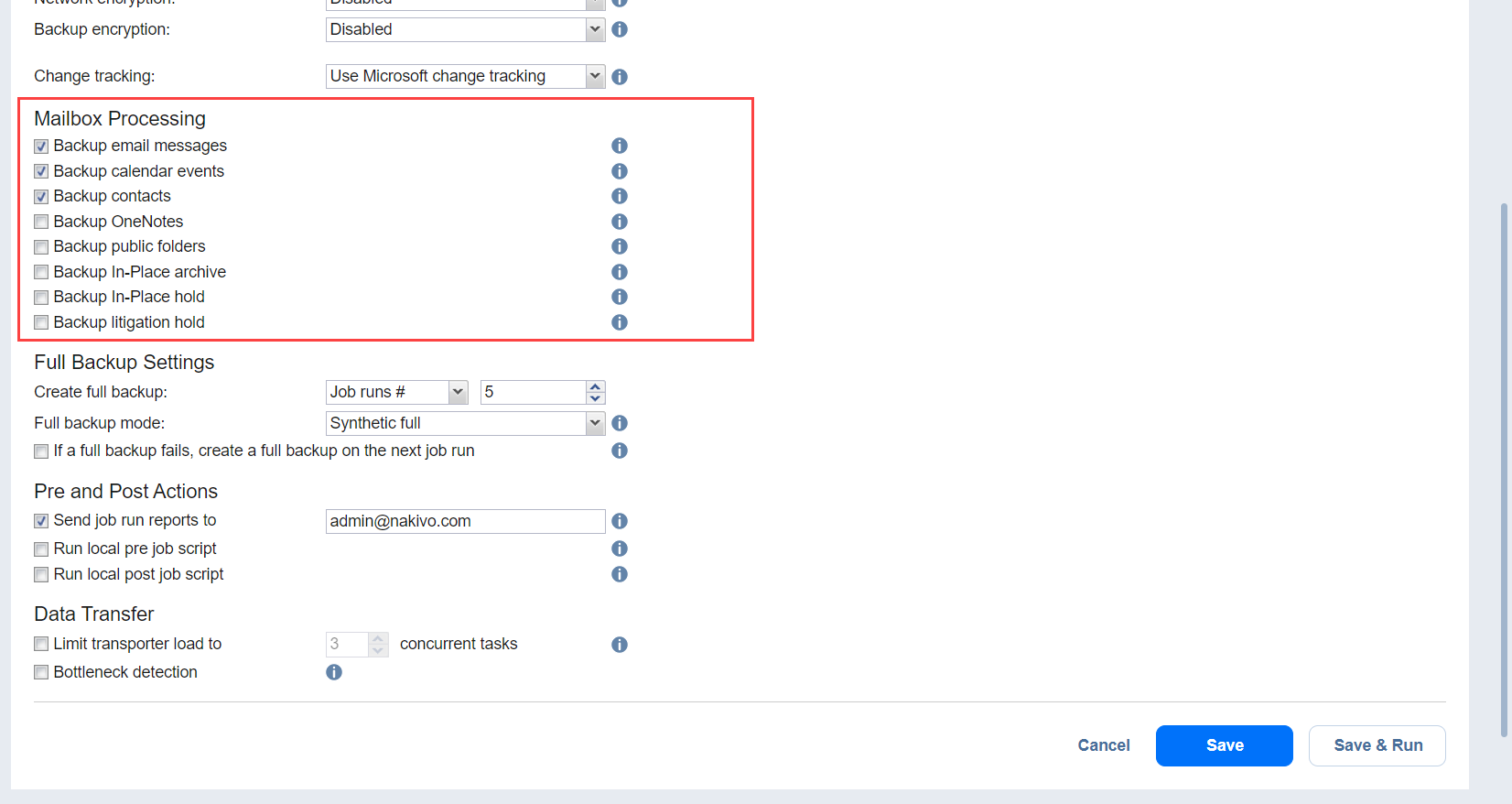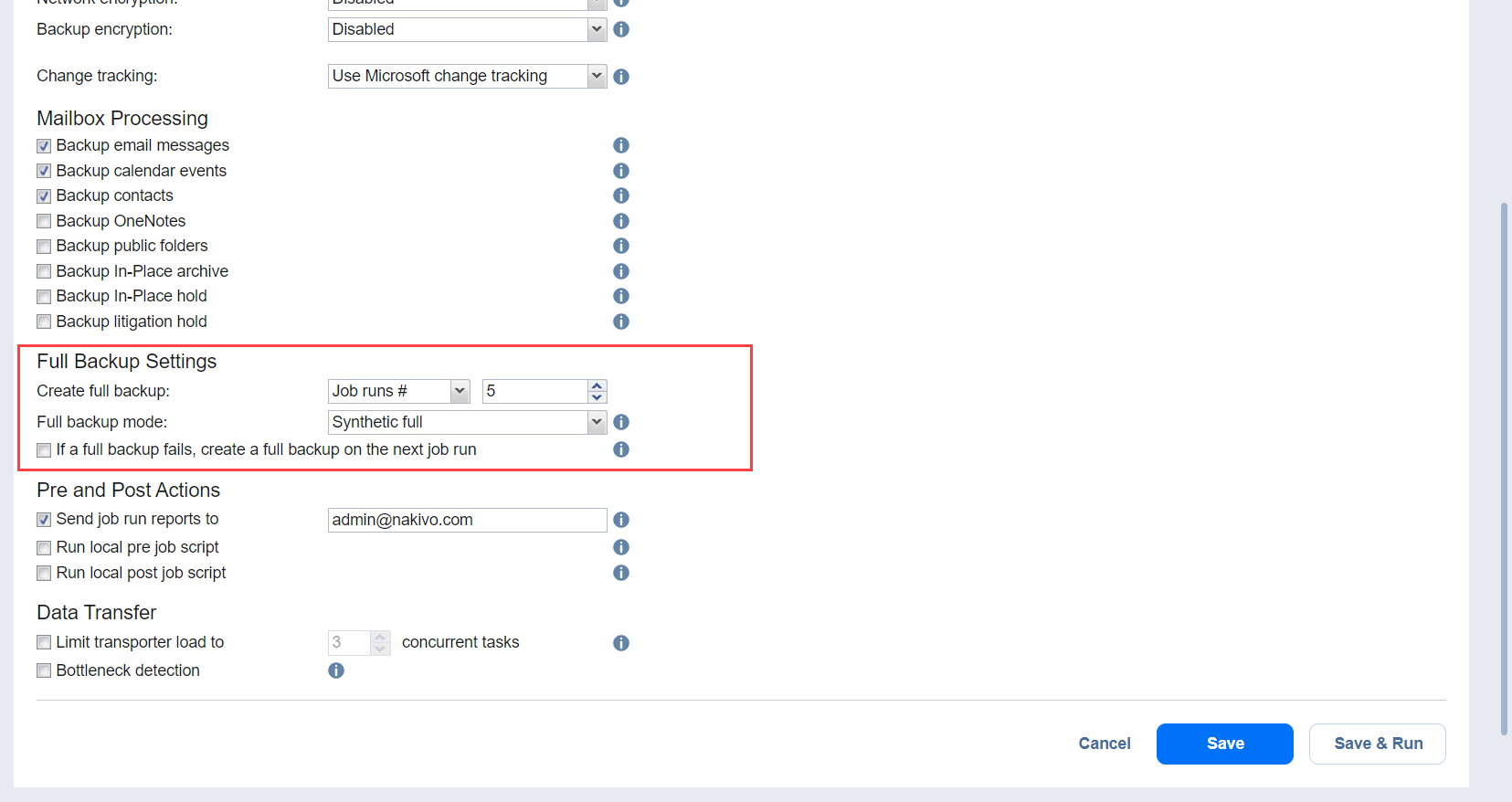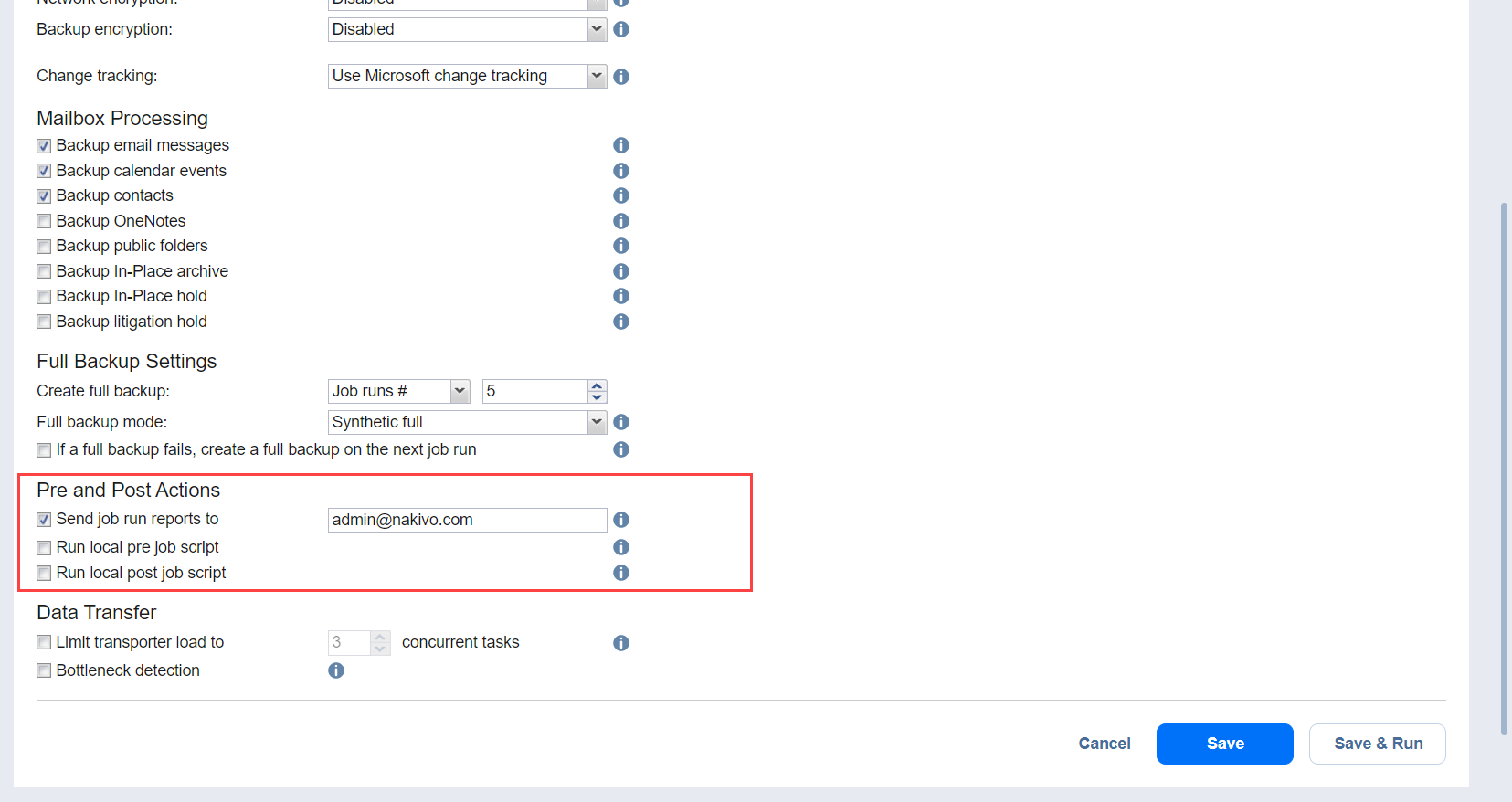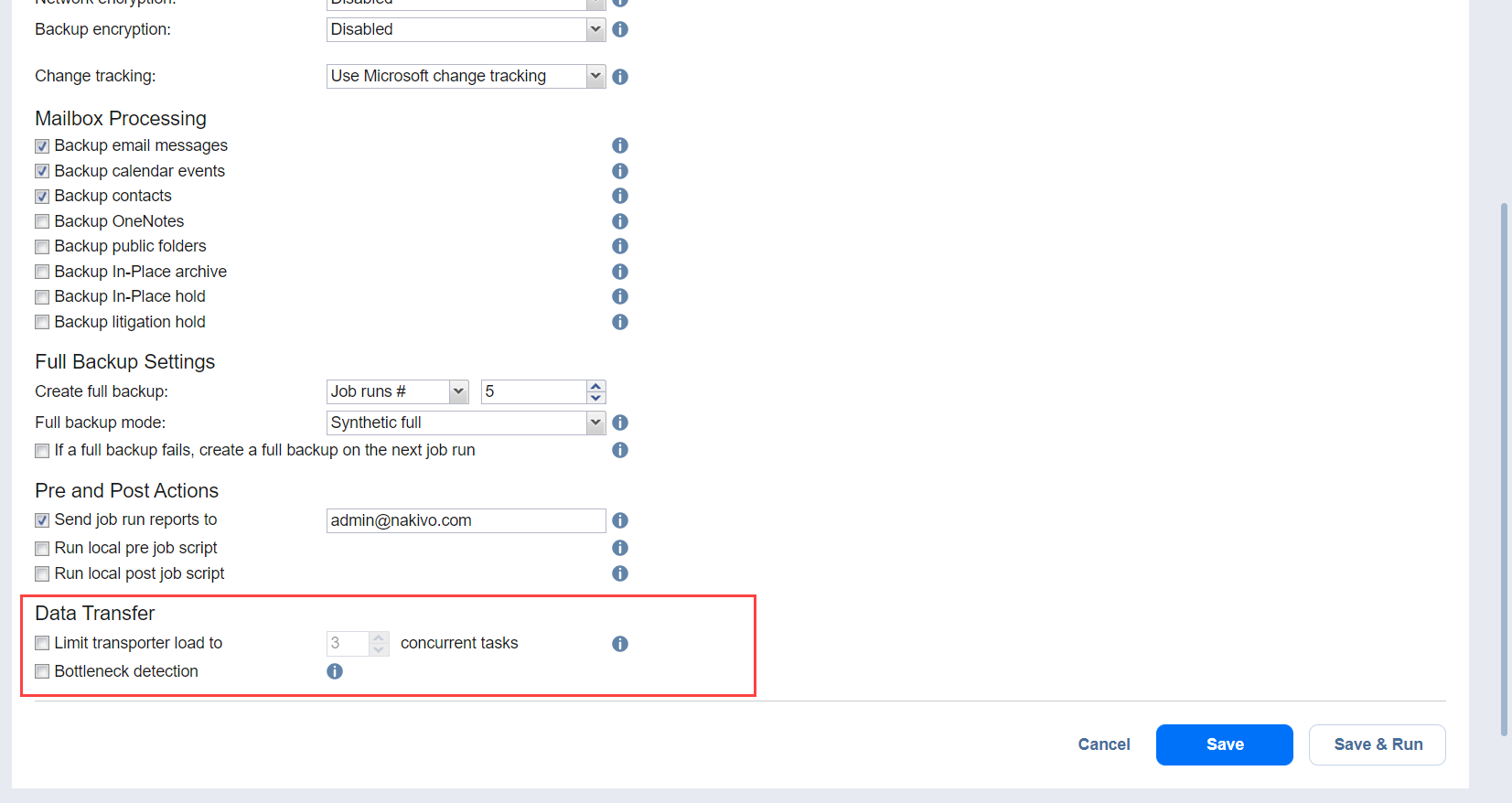Backup Job Wizard for Microsoft 365: Options
On the Options page, you can specify the job’s name, define pre- and post-job actions, and limit the Transporter load. Proceed as described in these sections:
Job Options
In this section, you can specify a name and a priority level for the backup job, change tracking, encryption, and other options. Proceed as described below:
-
Enter a name for the job to the Job name field.
-
Select a Job priority level between 1 and 5, with 1 being the highest priority. Jobs with higher priority levels are prioritized by Transporters during job processing.
Note
This option is only available in the Enterprise, Enterprise Essentials, Enterprise Plus, MSP Enterprise, and MSP Enterprise Plus editions.
-
-
Configure Change tracking. Do the following:
-
Choose from the following options in the dropdown menu:
-
Use Microsoft change tracking: With this option selected, after the initial job run, NAKIVO Backup & Replication uses Microsoft APIs to process exclusively the changed data from the last job run. This allows for a significant increase in processing speed.
-
Use proprietary method: With this option selected, NAKIVO Backup & Replication performs an incremental backup using the NAKIVO proprietary change tracking technology.
-
No change tracking (always full): When change tracking is disabled, the full data set is transferred on every job run.
-
-
Optionally, click settings to select one of the following job behaviors in relation to the Microsoft change tracking error:
-
switch to proprietary method: If Microsoft change tracking fails to provide information on changed data for an object and this option is selected, NAKIVO Backup & Replication performs an incremental backup of the object using the NAKIVO proprietary change tracking technology.
-
fail object processing: If Microsoft change tracking fails to provide information on changed data for an object and this option is selected, NAKIVO Backup & Replication does not process the object and the job is failed.
Notes
-
The Change tracking option is only displayed if at least one team is selected in the Sources step and its account has disabled Teams Export APIs.
-
If the Use Microsoft change tracking option is selected, the product uses delta queries in Microsoft Graph API to process only the changed data from the last run for Teams chat messages.
-
The following items are not supported and the proprietary method is used by default:
-
Contact lists
-
Mailboxes and its content
-
Public folder items
-
SharePoint Online sites and lists
-
OneNotes.
-
-
OneDrive files (including group mailbox files) and document libraries use delta queries by default and no configuration in the product is necessary.
-
The first backup run after switching to Use Microsoft change tracking may take longer to process, as it re-scans all source data using Microsoft change tracking.
-
-
-
-
If the type of the Backup Repository that you've selected on the Destination page of the wizard is set to Incremental with full backups (Store backups in separate files option is selected), you can specify the following options:
-
Network Acceleration: When enabled, NAKIVO Backup & Replication uses compression and traffic reduction techniques to speed up data transfer. Select this option if you plan to back up over WAN or slow LAN links.
Note
The Network acceleration option is not available if the Backup encryption option is enabled.
-
Network Encryption: When enabled, VM data is protected with AES 256 encryption while traveling over the network.
-
Data encryption increases the backup time and CPU load on machines running Transporters. Select this option if you back up over WAN without a VPN connection.
-
You need at least one Transporter at source and target sites to enable network encryption.
-
-
-
Configure Backup encryption to protect your backup data with AES 256 block cipher encryption with a 256-bit key length. You can protect the backup file by creating a new password or selecting an existing one. For more information, refer to Enabling Backup Encryption.
Note
It’s recommended that you enable the (AWS) Key Management Service. If KMS is enabled, all backup encryption passwords encrypted with the Key Management Service cryptographic key are available for recovery in case of product re-installation. For more information, refer to Enabling KMS.
Notes
If Backup encryption is enabled, the created recovery points are encrypted.
The Backup encryption option is not displayed for a backup job where forever incremental repositories are selected as the only target repositories.
The Backup encryption feature is not supported for Microsoft 365 backup jobs where SaaS repository is the only selected target repository type or one of repositories. Backup encryption is supported for Microsoft 365 backup jobs where only stream repositories are selected as target repositories.
Mailbox Processing
If you selected a mailbox on the Source page of the wizard, select at least one of the following mailbox items for backup by checking the respective option(s):
-
Email messages
-
Calendar events
-
Contacts
-
OneNotes
-
Public folders
-
In-Place archive
-
In-Place hold items
-
Litigation hold items
-
Group mailbox files
Notes
Selecting Back up Group mailboxes files may cause some files to be duplicated if you are also backing up the connected Group Site.
Selecting Back up public folders may cause the folders to be duplicated if you back up other mailboxes with the same folders. Only public folders located in the
IPM_SUBTREEfolder can be backed up. Other public folders are skipped.
If NAKIVO Backup & Replication is updated from a version that did not include support for Microsoft 365 Groups to a version that does, the Back up Group mailboxes files option is not selected automatically.
If other Microsoft 365 items were selected in addition to Exchange Online Group mailboxes , the Backup Group mailboxes files option can still be selected and applies only to group mailboxes.
Full Backup Settings
If the type of the Backup Repository that you've selected on the Destination page of the wizard is set to Incremental with full backups (Store backups in separate files option is selected), you can specify the following options:
-
Create full backup: Specify how often full backups should be created.
-
Full backup mode: Specify how the full backup should be created. You can choose one of the following options:
-
Synthetic Full: When this option is selected, NAKIVO Backup & Replication first performs an incremental backup (that is, transfers only the data that has changed since the last backup) and then transforms the available data into a full backup file. The benefits of this approach are:
-
The Synthetic Full backup is usually faster than the Active Full backup.
-
The load on the network is lower as less data is transferred.
-
The load on the source datastores running your production VMs is lower.
-
-
Active Full: When this option is selected, NAKIVO Backup & Replication reads all VM data from the source datastore and transfers it to the Backup Repository.
-
-
If a full backup fails, create a full backup on the next job run: With this option selected, the next job run creates a full backup if the current job run fails to do so.
Notes
-
A recovery point of a Microsoft 365 backup stored in an Incremental with full repository may have a bigger size compared to the same recovery point stored in a SaaS repository because each recovery point in Incremental with full repositories has an individual embedded database versus SaaS repositories, which only has one database for all recovery points.
-
Compression rates for Microsoft 365 items stored in Incremental with full repositories may vary depending on the items that are backed up; no minimum compression rate can be defined.
-
Synthetic full backups may have larger sizes than Active full backups because with Active full backups, empty clean metadata databases are created. As for Synthetic Full backup, metadata database from the previous successful savepoint is taken, and it's content is modified (add delta data in it. etc).
-
During a backup run, the database file is processed and consumes some data. The size of this file may be displayed in transferred data size.
-
Pre and Post Job Actions
With NAKIVO Backup & Replication, you can enable certain actions before a backup job begins and after it is completed. You can choose to send job run reports and run local pre- and post-job scripts. For more information, refer to Pre and Post Job Scripts.
Email Notifications
NAKIVO Backup & Replication can send email notifications on job completion status to specified recipients. This feature complements global notification and allows you to configure notifications on a per-job level.
Note
To enable this option, configure your email settings. For details, refer to Email Settings.
To send email notifications, select Send job run reports to and specify one or more email addresses in the text box. Use the semi-colon character (;) to separate multiple email addresses.
Pre Job Script
To run a script before the product begins backing up your items, do the following:
-
Place a script file on the machine on which the Director is installed.
-
Select the Run local pre job script option.
-
Specify the following parameters in the dialog box that opens:
-
Script path: Specify a local path to the script on the machine on which the Director is installed. The script interpreter should be specified.
Example (Windows): cmd.exe /c D:\script.batExample (Linux): bash /root/script.sh
-
Job behavior: Choose one of the following job behaviors in relation to script completion:
-
Wait for the script to finish: When this option is selected, the backup is started only after the script is completed.
-
Do not wait for the script to finish: When this option is selected, the product runs the script and starts backing up your items at the same time.
-
-
Error handling: Choose one of the following job behaviors in relation to script failure:
-
Continue the job on script failure: When this option is selected, the product performs the backup job even if the script has failed.
-
Fail the job on script failure: When this option is selected and the script fails, the job fails and the backup is not performed.
-
-
Post Job Script
To run a script after the product has finished backing up all items, do the following:
-
Place a script file on the machine on which the Director is installed.
-
Select the Run local post job script option.
-
Specify the following parameters in the dialog box that opens:
-
Script path: Specify a local path to the script on the machine on which the Director is installed. The script interpreter should be specified.
Example (Windows): cmd.exe /c D:\script.bat
Example (Linux): bash /root/script.sh
-
Job behavior: Choose one of the following job behaviors in relation to script completion:
-
Wait for the script to finish: When this option is selected, the job remains in the “running” state until the script is completed.
-
Do not wait for the script to finish: When this option is selected, the job is completed even if the script execution is still in progress.
-
-
Error handling: Choose one of the following job behaviors in relation to script failure:
-
Continue the job on script failure: When this option is selected, script failure does not influence the status of the job.
-
Fail the job on script failure: When this option is selected and the script fails, the job status is set to “failed” even if backup is successful.
-
-
Note
Pre- and post-job scripts can be executed only on the machine on which the Director is installed.
Data Transfer
In the Data Transfer section, you can configure the following options.
Transporter Load
You can limit the maximum number of Transporter tasks used by a job. By default, the number is set to 3 concurrent tasks. For a Microsoft 365 backup job, one task is equal to processing one mailbox or one OneDrive instance.
To change the default number of tasks, do the following:
-
In the Data Transfer section, select the Limit transporter load to checkbox.
-
Specify the number of concurrent tasks in the corresponding box.
Bottleneck Detection
When the Bottleneck detection option is enabled, additional information is collected and recorded in NAKIVO Backup & Replication logs in the course of data transfer for the purpose of bottleneck detection. Check this option to enable the Bottleneck detection capability of the Transporters engaged in the job.
Completing the New Backup Job Wizard for Microsoft 365
Click Finish or Finish & Run to complete the job creation.
Note
If you click Finish & Run, you will have to define the scope of your job.
